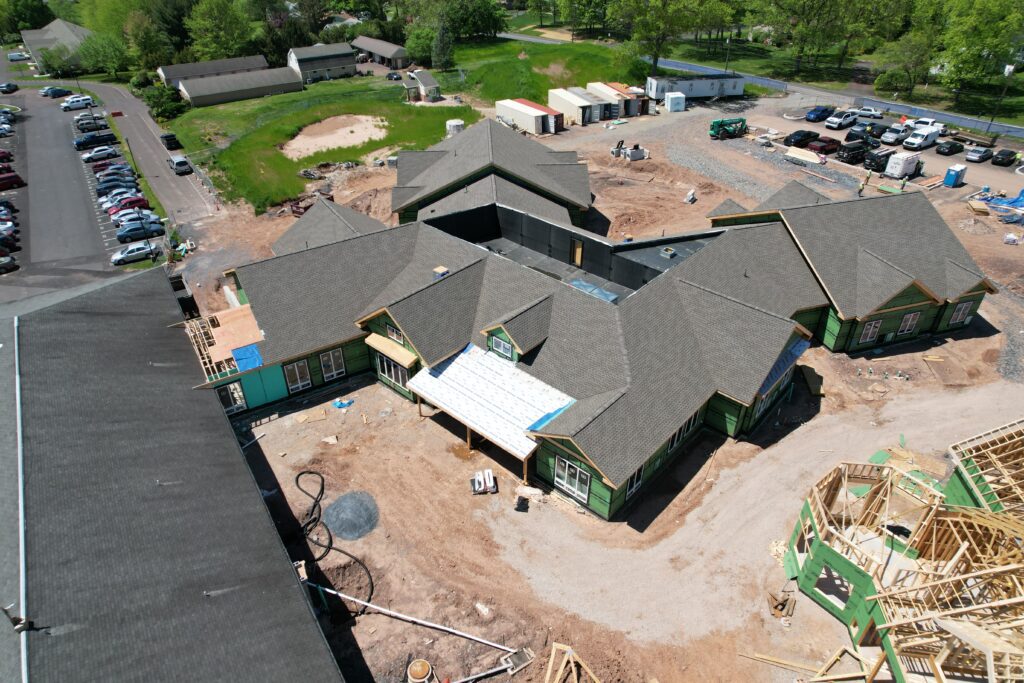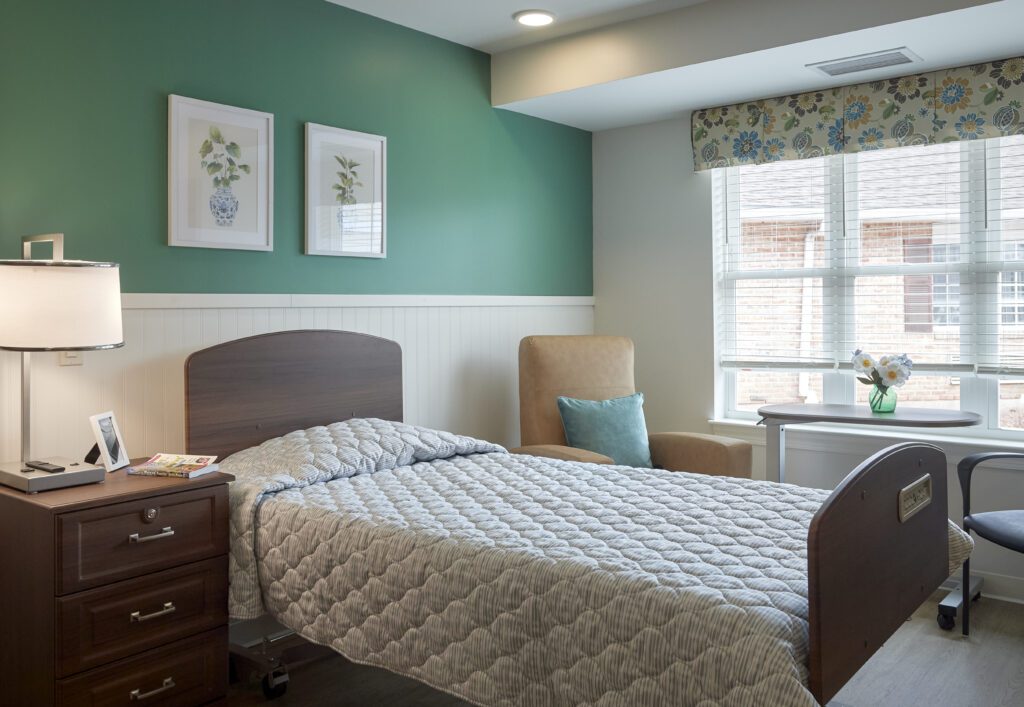“Transformative.”
“A dramatic difference.”
“Game changer.”
Talk to Naomi Hawkins, director of Health Care Services for Dock Woods, and you’ll hear her use these terms for Country Cottage: a unique neighborhood at Dock Woods for Health Care residents with dementia.
“Residents often have a decrease in anxiety when they move from Dock Terrace to Country Cottage,” Naomi said. “In this more intimate environment, there’s an overall feeling of calm.”
But more than two decades after Country Cottage first opened its doors at Dock Woods, Living Branches leadership knew it needed a refresh – more space, more privacy, and more opportunities for resident engagement.
As importantly, Living Branches wanted to bring these unique benefits to Souderton Mennonite Homes, which has never had a Memory Care neighborhood within Health Care. Its existing Memory Care neighborhood, Park View, is available only for Personal Care residents.
“We’ve always been in the business of caring for those who are less able to advocate for themselves,” said Edward D. Brubaker, President/CEO of Living Branches. “From my perspective, it’s a question of doing the right thing. And the right thing is to have a Memory Care community in Health Care.”

Constructing the Future of Memory Care
As the first new Memory Care neighborhood to be transformed at Living Branches, the latest iteration of Country Cottage welcomed residents in mid-2023. The new Country Cottage is brand new, along with other areas in Dock Terrace that have been newly built or extensively renovated.
Construction is almost complete on the other new Memory Care neighborhoods at Souderton Mennonite Homes, too. One neighborhood will be for Personal Care residents and the other for Health Care, just like Country Cottage.
Despite numerous benefits for residents, most senior living communities do not offer Memory Care neighborhoods within skilled nursing. It usually comes down to cost: building new facilities and staffing them with a dedicated team is not within every organization’s means.
For most for-profit corporations, these costs do not align with the need to generate the highest return on shareholder investments. But as a non-profit, Living Branches is able to think about investments differently, focusing on what is needed now and down the road.
“We have to have a positive bottom line, but that bottom line is there to be reinvested in the future of the organization,” Ed explained. “We have to think about what’s best for our residents, families, and team members to make sure we’re here to serve our community for generations to come.”
Work at both campuses was funded in part by Rooted in Love, Growing Together: The Campaign for Living Branches. Local individuals and organizations contributed more than $3.5 million toward the campaign, which wrapped at a donor celebration at Souderton Mennonite Homes in June 2024.
“Generous board members, residents, and partners of Living Branches recognized the need for this kind of care and generously contributed to the campaign,” said Keith Heavener, director of fund development at Living Branches. “These projects have always been more than just new buildings. They are transforming how our residents and community benefit from Memory Care for years to come.”
Additional funds for work at Souderton Mennonite Homes came from the Redevelopment Assistance Capital Program, thanks to advocacy from state Senator Maria Collett and Representative Steve Malagari.

The Benefits of Memory Care in Health Care
Later this summer, Souderton Mennonite Homes will open its own version of Country Cottage, with many design and layout elements drawing inspiration from the success of the new Country Cottage.
Naomi points to several reasons residents tend to thrive in Country Cottage – and will likely benefit from the same kind of care at Souderton Mennonite Homes.
“The environment itself is smaller and built like a home, and caregivers are more plentiful and consistent,” she said. “There’s less stimulation because the community is centrally built with rooms off to the sides, which lets our team monitor for safety and medical needs. We also see fewer wandering behaviors and higher engagement in life enrichment activities throughout the day.”
Jill Arroyo, director of Health Care services at Souderton Mennonite Homes, echoes this excitement for a more nurturing space. “I’m looking forward to seeing residents and their families experience a calmer environment,” she said. “The new neighborhood will afford person-centered engagement and a visually pleasing environment that lets us focus on what residents CAN do.”
In Country Cottage and its sister Memory Care community at Souderton Mennonite Homes, thoughtful design elements enhance these benefits:
- Spacious common areas promote social and life enrichment activities, offering more areas where residents can be together or take a restorative moment alone.
- Special rhythm lighting mimics the sun’s patterns, helping to regulate residents’ circadian rhythm and promote a more natural sleep cycle.
- Larger windows provide ample natural light, brightening spaces and helping residents feel more connected to their environment.
- Bright, modern colors on the walls, carpet, and artwork create a more home-like, attractive atmosphere.
- Sensory plantings, accessible garden beds, and electricity for instruments and speakers in the courtyard enrich residents’ outdoor experiences.
- Break rooms allow team members to pause and recharge throughout their workday.
“The natural light has made such a difference,” says Rhoda, whose husband lives in Country Cottage. “The big skylights and lower windows in the residents’ rooms are wonderful. And when we have extra relatives coming, we use the family room quite a bit. Six or seven family members from out of town have been able to visit at once.”

Room to Grow Together
For Ed private rooms are another way Living Branches is “doing the right thing.” When his parents lived in a Life Plan Community, he saw firsthand the difference a private room can make.
“It’s been a longtime vision of mine to have more private rooms,” Ed said. “When my mom moved from Memory Care at the Personal Care level into Health Care, having a private room was a big deal. While I understand the cost perspective of asking residents to share, it’s more dignified to give them their own space.”
Naomi has already seen the difference between companion suites and private rooms and is excited for Souderton Mennonite Homes to offer similar residences in Memory Care.
“Private rooms have been transformative for residents,” she explained. “We see fewer anxiety-related behaviors and conflict between residents. Private rooms also give each resident a retreat after spending time with a larger group and allow them to add more personal touches, helping them feel oriented in their new home.”
The new rooms also offer more room for equipment and space to help residents with transferring and repositioning. And activities of daily living, including hygiene and grooming, are less challenging with private bathrooms, Naomi added. Team members can care for residents’ needs more easily when they don’t have to walk down the hallway to a shared shower. “It’s more like what they would have been used to at home,” Naomi said.
Families also enjoy visits more thanks to the new private rooms and common areas.
“Family members are really, really thankful for the private rooms,” Naomi explained. “I do tend to see more families bringing in younger kids because there’s more space for them in resident rooms, the den, and the outdoor patio space. Whether they remember them or not, visitors bring residents – and everyone else in the neighborhood – a lot of joy.”
“It’s a game changer,” she continued, “to have all that space available to engage people of different abilities at different levels.”

